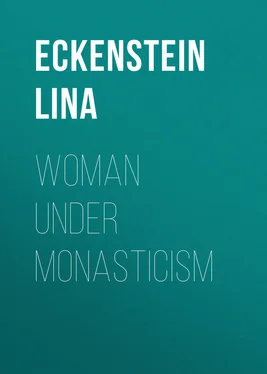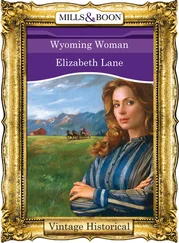Lina Eckenstein - Woman under Monasticism
Здесь есть возможность читать онлайн «Lina Eckenstein - Woman under Monasticism» — ознакомительный отрывок электронной книги совершенно бесплатно, а после прочтения отрывка купить полную версию. В некоторых случаях можно слушать аудио, скачать через торрент в формате fb2 и присутствует краткое содержание. Жанр: История, foreign_antique, foreign_prose, на английском языке. Описание произведения, (предисловие) а так же отзывы посетителей доступны на портале библиотеки ЛибКат.
- Название:Woman under Monasticism
- Автор:
- Жанр:
- Год:неизвестен
- ISBN:нет данных
- Рейтинг книги:4 / 5. Голосов: 1
-
Избранное:Добавить в избранное
- Отзывы:
-
Ваша оценка:
- 80
- 1
- 2
- 3
- 4
- 5
Woman under Monasticism: краткое содержание, описание и аннотация
Предлагаем к чтению аннотацию, описание, краткое содержание или предисловие (зависит от того, что написал сам автор книги «Woman under Monasticism»). Если вы не нашли необходимую информацию о книге — напишите в комментариях, мы постараемся отыскать её.
Woman under Monasticism — читать онлайн ознакомительный отрывок
Ниже представлен текст книги, разбитый по страницам. Система сохранения места последней прочитанной страницы, позволяет с удобством читать онлайн бесплатно книгу «Woman under Monasticism», без необходимости каждый раз заново искать на чём Вы остановились. Поставьте закладку, и сможете в любой момент перейти на страницу, на которой закончили чтение.
Интервал:
Закладка:
During the later Middle Ages the study of the influences at work in the convent is further complicated by the development of religious associations outside it. Pre-eminent among these stands the school of Deventer which gave the impulse to the production of a devotional literature, the purity and refinement of which has given it world-wide reputation. These associations were founded by men not by women, and though the desire to influence nuns largely moulded the men who wrote for and preached to them, still the share taken by women in such movements is entirely subordinate.
It is needless to multiply instances of the chapters on convent life which are here omitted; in those which I place before the reader it has been my aim not so much to give a consecutive history of monasticism as it affected women, as to show how numerous are the directions in which this history can be pursued. Having regard to the nature of the subject I have addressed myself in the first place to the student, who in the references given will, I trust, find corroboration of my views. In quoting from early writings I have referred to the accounts printed in the Acta Sanctorum Bollandorum and to the edition of Latin writings published under the auspices of Migne in the ‘Patrologiae Cursus Completus,’ except in those few cases where a more recent edition of the work referred to offered special advantages, and regarding the date of these writings I have been chiefly guided by A. Potthast, Wegweiser durch die Geschichtswerke des europäischen Mittelalters , 1862. In accordance with a division which has been adopted by some histories of art and seems to me to have much in its favour, I have taken Early Christian times to extend to the close of the 10th century; I have spoken of the period between 1000 and 1250 as the Earlier, and of that between 1250 and 1500 as the Later Middle Ages. The spelling of proper names in a work which extends over many centuries has difficulties of its own. While observing a certain uniformity during each period, I have as far as possible adhered to the contemporary local form of each name.
While addressing myself largely to the student, I have kept along lines which I trust may make the subject attractive to the general reader, in whose interest I have translated all the passages quoted. There is a growing consciousness now-a-days that for stability in social progress we need among other things a wider scope for women’s activity. This scope as I hope to show was to some extent formerly secured to women by the monastic system. Perhaps some of those who are interested in the educational movements of to-day may care to recall the history and arrangements of institutions, which favoured the intellectual development of women in the past.
I cannot conclude these prefatory remarks without a word of thanks to those who have aided me by criticism and revision. Besides the two friends to whom I have dedicated this book, I have to cordially thank Mrs R. W. Cracroft for the labour she has spent on the literary revision of my work in manuscript. To Dr H. F. Heath of Bedford College I am indebted for many suggestions on points of philology, and to Robert J. Parker, Esq. of Lincoln’s Inn for advice on some points of law and of general arrangement. Conscious as I am of the many defects in my work, I cannot but be grateful to the Syndics of the University Press, for the assistance they have rendered me in its publication, and I trust that these defects may not deter readers from following me into somewhat unfrequented paths, wherein at any rate I have not stinted such powers of labour as are mine.
LINA ECKENSTEIN.
December, 1895.CHAPTER I
INTRODUCTORY
‘Die mit dem goldenen Schuh und dem Geiger ist auch eine Muttergottes.’
Bavarian Saying.§ 1. The Borderland of Heathendom and Christianity
In order to gain an insight into the causes of the rapid development of monasticism among the German races, it is necessary to enquire into the social arrangements of the period which witnessed the introduction of Christianity, and into those survivals of the previous period of social development which German Christianity absorbed. Among peoples of German race monastic life generally, and especially monastic life which gave scope for independent activity among women, had a development of its own. Women of the newly-converted yet still barbarian race readily gathered together and dwelt in religious settlements founded on their own initiative and ruled independently of men. A reason for this must be sought in the drift of contemporary life, which we shall thus have to discuss at some length.
During the period of declining heathendom – for how long, measuring time by centuries, it is not yet possible to say – the drift of society had been towards curtailing woman’s liberty of movement and interfering with her freedom of action. When the Germans crossed the threshold of history the characteristics of the father-age were already in the ascendant; the social era, when the growing desire for certainty of fatherhood caused individual women and their offspring to be brought into the possession of individual men, had already begun. The influence of women was more and more restricted owing to their domestic subjection. But traditions of a time when it had been otherwise still lingered.
Students of primitive history are recognising, for peoples of German race among others, the existence of an early period of development, when women played a greater part in both social and tribal life. Folk-lore, philology, and surviving customs yield overwhelming evidence in support of the few historic data which point to the period, conveniently called the mother-age, when women held positions of authority inside the tribal group and directly exercised influence on the doings of the tribe 1 1 The literature on this subject is daily accumulating. Among older authorities are Bachofen, Das Mutterrecht , 1861; Zmigrodski, Die Mutter bei den Völkern des arischen Stammes , 1886; Pearson, K., Ethic of Free Thought , 1888.
.
This period, the mother-age, is generally looked upon as an advance from an earlier stage of savagery, and considered to be contemporaneous with the beginnings of settled tribal life. It brought with it the practice of tilth and agriculture, and led to the domestication of some of the smaller animals and the invention of weaving and spinning, achievements with which it is recognised that women must be credited.
In matters of polity and sex it established the paramount importance of the woman; it is she who regulates the home, who notes the changes of the seasons, who stores the results of experience, and treasures up the intellectual wealth of the community in sayings which have come down to us in the form of quaint maxims and old-world saws. As for family arrangements, it was inside the tribal group and at the tribal festival that sex unions were contracted; and this festival, traditions of which survive in many parts of Europe to this day, and which was in its earliest forms a period of unrestrained license for the women as well as the men, was presided over by the tribal mothers, an arrangement which in various particulars affords an explanation of many ideas associated with women in later times.
The father-age succeeding to the mother-age in time altogether revolutionised the relations of the sexes; transient sex unions, formerly the rule, were gradually eliminated by capture and retention of wives from outside the tribal group. The change marks a distinct step in social advance. When men as heads of families succeeded to much of the influence women had held in the tribe, barbarous tendencies, such as blood sacrifice, were checked and a higher moral standard was attained. But this was done at the cost of her prerogative to the woman; and her social influence to some extent passed from her.
Читать дальшеИнтервал:
Закладка:
Похожие книги на «Woman under Monasticism»
Представляем Вашему вниманию похожие книги на «Woman under Monasticism» списком для выбора. Мы отобрали схожую по названию и смыслу литературу в надежде предоставить читателям больше вариантов отыскать новые, интересные, ещё непрочитанные произведения.
Обсуждение, отзывы о книге «Woman under Monasticism» и просто собственные мнения читателей. Оставьте ваши комментарии, напишите, что Вы думаете о произведении, его смысле или главных героях. Укажите что конкретно понравилось, а что нет, и почему Вы так считаете.












